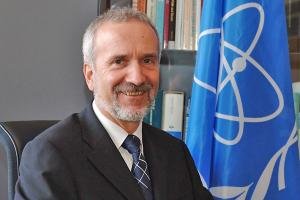Fusion—towards global energy supply
14 May 2010
-
Werner Burkart, IAEA Deputy Director-General, Department of Nuclear Sciences and Applications
As the world population rises to reach a projected nine billion by 2050, one of the greatest challenges faced by countries worldwide is finding sustainable, clean and predictable sources of energy to support development and ensure a decent standard of living for their citizens.
This challenge has been present for humans since the dawn of time, from when our ancestors had to carry flaming torches from one camp to the next, before they knew even how to start a fire.
At present, most of the world's energy supplies come from fossil fuels, which are finite and which come at a high environmental cost. This has lead many nations to the conclusion that it is high time to diminish their reliance on carbon-based energy such as coal, gas and oil. Consequently, renewable energy sources, such as solar, wind, hydro and nuclear fission have emerged as possible substitutes and are growing in use in many parts of the world.
At the same time, hovering in the background and slowly gaining momentum is fusion power, a technology modelled after the sun's natural means of generating energy that has been under research for over 60 years, and that offers the possibility of low-waste and almost unlimited fuel supplies.
The potential of controlled nuclear fusion as a major part of the world energy supply was recognized at the very beginning of this scientific journey. In 1961, the IAEA held its first conference on Plasma Physics and Thermonuclear Fusion, in Salzburg. In his conference report, D.R. Sweetman wrote: "...the days of crude experiments, quickly done, are past and we are settling down to a period of careful experimentation in well-defined geometries."
He may not have known that it would take another 50 years to finally reach the device scale, promising burning plasmas which constitute ITER.
Over the past few years, and especially since the 2008 signing of the IAEA-ITER Cooperation Agreement, ITER has been an increasing source of interest for the IAEA's 151 Member States. No longer a facilitator for ITER's development the IAEA is now a partner—albeit a modest one—for ITER, representing its Member States in the search for a lasting solution to future energy demands.
The same scientific questions that ITER confronts also dominate many technical meetings at the IAEA, which demonstrates its own commitment to fusion research through activities in plasma physics, materials science and fusion-related technology. In carrying out these activities, we have supported controlled magnetic confinement fusion as the main road to a commercial fusion power plant, while keeping an eye on the development of inertial fusion and its varied possibilities through applications such as laser, z-pinch, or heavy ion driven plasmas.
Most urgently, however, we see a growing need to share the results of ITER's work with our Member States and beyond, as this work holds the promise of scientific and technological benefits beyond the generation of fusion energy. For example, the world can benefit in multiple ways from plasma and surface science, the development and use of new heat and radiation materials as well as from IT technology developed at ITER.
Significantly, this can be a two-way flow of knowledge and expertise. The IAEA is unique as a global hub of information regarding current and new approaches to all aspects of fission energy production and the use of related materials. This know-how, gained over many years through work with a wide variety of Member States and other partners, can certainly be beneficial to the fusion community.
One of the most important lessons learned from ITER is that a United Nations organization with limited resources, but formidable expertise, can help to kick-start and ultimately partner with a multi-billion euro endeavour involving Member States representing over half of the world's population.
Perhaps the next lesson we can learn together is how two such partners, with a shared interest in fusion as a potential response to the world's energy challenges, can continue to work together to deliver the greatest possible benefits to the greatest number of people.


